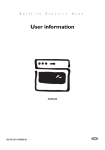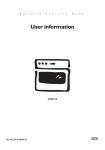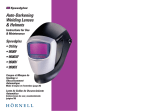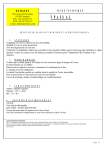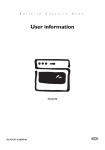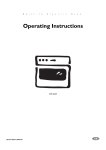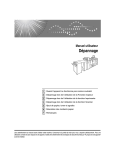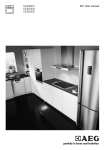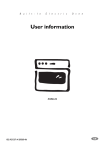Download Electrolux EOB2610 User's Manual
Transcript
B u i l t - I n E l e c t r i c O v e n User information EOB2610 822 923 225-A-180203-05 g Dear Customer, Please read this instruction book carefully. Above all, please observe the “safety” section on the first few pages. Please retain this instruction book for later reference. Pass them on to any subsequent owners of the appliance. 1 3 2 The following symbols are used in the text: Safety Instructions Warning: Information concerning your personal safety. Important: Information on how to avoid damaging the appliance. Information and practical tips Environmental information 1.These numbers indicate step by step how to use the appliance. 2.… 3.… These operating instructions contain information on steps you can take yourself to rectify a possible malfunction. Refer to the section “What to do if...”. 2 Contents Operating Instructions . . . . . . . . . . . . . . . . . . . . . . . . . . . . . . . . . . . . . 5 Safety . . . . . . . . . . . . . . . . . . . . . . . . . . . . . . . . . . . . . . . . . . . . . . . . . . . . . . . 5 Disposal . . . . . . . . . . . . . . . . . . . . . . . . . . . . . . . . . . . . . . . . . . . . . . . . . . . . . 6 Description of the Appliance . . . . . . . . . . . . . . . . . . . . . . . . . . . . . . . . . . . . General Overview . . . . . . . . . . . . . . . . . . . . . . . . . . . . . . . . . . . . . . . . . . . . . . Control Panel. . . . . . . . . . . . . . . . . . . . . . . . . . . . . . . . . . . . . . . . . . . . . . . . . . Oven Features . . . . . . . . . . . . . . . . . . . . . . . . . . . . . . . . . . . . . . . . . . . . . . . . . Oven Accessories . . . . . . . . . . . . . . . . . . . . . . . . . . . . . . . . . . . . . . . . . . . . . . 7 7 8 8 9 Before using for the first time . . . . . . . . . . . . . . . . . . . . . . . . . . . . . . . . . . . Initial Cleaning. . . . . . . . . . . . . . . . . . . . . . . . . . . . . . . . . . . . . . . . . . . . . . . . . 10 10 Operating the Oven . . . . . . . . . . . . . . . . . . . . . . . . . . . . . . . . . . . . . . . . . . . . Switching the Oven On and Off . . . . . . . . . . . . . . . . . . . . . . . . . . . . . . . . . . . Oven Functions . . . . . . . . . . . . . . . . . . . . . . . . . . . . . . . . . . . . . . . . . . . . . . . . Attaching/Removing the Grill Pan Handle. . . . . . . . . . . . . . . . . . . . . . . . . . . . Minute Minder . . . . . . . . . . . . . . . . . . . . . . . . . . . . . . . . . . . . . . . . . . . . . . . . . 11 11 12 13 14 Usage, Tables and Tips. . . . . . . . . . . . . . . . . . . . . . . . . . . . . . . . . . . . . . . . . Baking . . . . . . . . . . . . . . . . . . . . . . . . . . . . . . . . . . . . . . . . . . . . . . . . . . . . . . . Baking Table. . . . . . . . . . . . . . . . . . . . . . . . . . . . . . . . . . . . . . . . . . . . . . . . Roasting . . . . . . . . . . . . . . . . . . . . . . . . . . . . . . . . . . . . . . . . . . . . . . . . . . . . . Roasting Table . . . . . . . . . . . . . . . . . . . . . . . . . . . . . . . . . . . . . . . . . . . . . . Grilling . . . . . . . . . . . . . . . . . . . . . . . . . . . . . . . . . . . . . . . . . . . . . . . . . . . . . . . Infrared Grilling. . . . . . . . . . . . . . . . . . . . . . . . . . . . . . . . . . . . . . . . . . . . . . Preserving . . . . . . . . . . . . . . . . . . . . . . . . . . . . . . . . . . . . . . . . . . . . . . . . . . . . 15 15 17 19 20 22 22 24 Cleaning and care . . . . . . . . . . . . . . . . . . . . . . . . . . . . . . . . . . . . . . . . . . . . . Exterior of the Appliance. . . . . . . . . . . . . . . . . . . . . . . . . . . . . . . . . . . . . . . . . Oven Interior . . . . . . . . . . . . . . . . . . . . . . . . . . . . . . . . . . . . . . . . . . . . . . . . . . Accessories. . . . . . . . . . . . . . . . . . . . . . . . . . . . . . . . . . . . . . . . . . . . . . . . . . . Shelf Support Rails . . . . . . . . . . . . . . . . . . . . . . . . . . . . . . . . . . . . . . . . . . . . . Oven Lighting . . . . . . . . . . . . . . . . . . . . . . . . . . . . . . . . . . . . . . . . . . . . . . . . . Oven Door . . . . . . . . . . . . . . . . . . . . . . . . . . . . . . . . . . . . . . . . . . . . . . . . . . . . Oven Door Glass . . . . . . . . . . . . . . . . . . . . . . . . . . . . . . . . . . . . . . . . . . . . . . . 26 26 26 26 27 28 29 30 What to do if … . . . . . . . . . . . . . . . . . . . . . . . . . . . . . . . . . . . . . . . . . . . . . . . 31 Technical Data . . . . . . . . . . . . . . . . . . . . . . . . . . . . . . . . . . . . . . . . . . . . . . . . Oven Interior Dimensions . . . . . . . . . . . . . . . . . . . . . . . . . . . . . . . . . . . . . . . . Regulations, Standards, Directives . . . . . . . . . . . . . . . . . . . . . . . . . . . . . . . . . 32 32 32 3 Installation Instructions . . . . . . . . . . . . . . . . . . . . . . . . . . . . . . . . . . . . Safety Instructions for the Installer . . . . . . . . . . . . . . . . . . . . . . . . . . . . . . . . . Electrical Connection . . . . . . . . . . . . . . . . . . . . . . . . . . . . . . . . . . . . . . . . . . . 33 33 34 Guarantee Conditions. . . . . . . . . . . . . . . . . . . . . . . . . . . . . . . . . . . . . . . . . . 40 Index . . . . . . . . . . . . . . . . . . . . . . . . . . . . . . . . . . . . . . . . . . . . . . . . . . . . . . . 42 Service and Spare Parts . . . . . . . . . . . . . . . . . . . . . . . . . . . . . . . . . . . . 43 4 Operating Instructions 1 Safety Electrical Safety • The appliance may only be connected by a qualified electrican / competent person. • In the event of any faults or damage to the appliance: remove fuses or switch off. • It is not permissible to clean the appliance with a steam or high pressure cleaner for safety reasons! • Repairs to the appliance may only be carried out by specialists. Repairs carried out by inexperienced persons may cause injury or serious malfunctioning. If your appliance needs repairing, please contact your local Service Force Centre or your specialist dealer. Child Safety • Never leave children unsupervised when the appliance is in use. Safety whilst Using • This appliance is intended to be used for cooking, frying and baking food in the home. • Take care when connecting electric appliances to sockets nearby. Do not allow connecting leads to come into contact with hot rings or to catch beneath the hot oven door. • Warning: Risk of burns! The interior of the oven becomes hot during use. • Using ingredients containing alcohol in the oven may create an alcohol-air mixture that is easily ignited. In this case, open the door carefully. Do not have embers, sparks or naked flames in the vicinity when opening the door. 5 To Avoid Damaging Your Appliance • Do not line your oven with aluminium foil and do not place a baking tray or dish on the oven floor, otherwise the oven enamel will be damaged by the resulting build up of heat. • Juice from fruit that drips from baking trays will leave marks that cannot be removed. For very moist cakes, use the universal baking tray. • Do not put any weight on the oven door when it is open. • Never pour water directly into the hot oven. The enamel may be damaged. • Using force, especially on the edges of the front glass panel, may break the glass. • Do not store inflammable objects in the oven. They may ignite when the oven is switched on. • Do not store moist food in the oven. The enamel may be damaged. 2 Disposal Disposing of the packaging material All materials used can be fully recycled. Plastics are marked as follows: • >PE< for polyethylene, as used for the outer wrapping and the bags inside. • >PS< for polystyrene foam, e.g., as used for the padding materials. They are completely free of CFCs. Disposal of old appliances 1 6 Warning: Before disposing of old appliances please make them inoperable so that they cannot be the source of danger. To do this, disconnect the appliance from the mains supply and remove the mains lead. To protect the environment, it is important that worn out appliances are disposed of in the correct manner. • The appliance must not be disposed of with household rubbish. • You can obtain information about collection dates or public refuse disposal sites from your local Council or Environmental Health Office. Description of the Appliance General Overview Control panel Door handle Full glass door 7 Control Panel Minute Minder (timer) Temperature Pilot Light Temperature Selection Oven Functions Oven Features Top heat and heating elements Oven lighting Shelf positions Bottom Heat Oven shelf runners, removable 8 Oven Accessories Combination shelf For dishes, cake tins, items for roasting and grilling. Grill pan with handle Support for the grill tray as a collecting vessel for fat Grill tray Insert for the grill pan for grilling smaller amounts of food 9 Before using for the first time Initial Cleaning 1 3 Before using the oven for the first time you should clean it thoroughly. Caution: Do not use any caustic, abrasive cleaners! The surface could be damaged. To clean any metal front panels use commercially available cleaning agents. 1.Turn the oven function switch to oven lighting L. 2.Remove all accessories and the shelf support rails and wash them with warm water and washing up liquid. 3.Then wash out the oven with warm water and washing-up liquid and dry. 4.Wipe the front of the appliance with a damp cloth. 10 Operating the Oven Switching the Oven On and Off Temperature Pilot Light Oven Functions Temperature Selection 1.Turn the “oven functions” switch to the required function. 2.Turn the “temperature selection” switch to the required temperature. The red temperature pilot light is only illuminated whilst the oven is heating up. 3.To switch off the oven, turn the “oven functions” switch and the “temperature selection” switch to the zero position. 3 Cooling fan When the oven is switched on, the fan comes on automatically to keep the surfaces of the appliance cool. When the oven is switched off, the fan continues to operate to cool the appliance down, then switches itself off. 11 Oven Functions The oven has the following functions: L Oven lighting With this function you can illuminate the oven interior e.g. for cleaning. The heating element is not in use. ¡ Conventional For baking or roasting on one level. The conventional heating elements are in use. O Top Heat For browning foods topped with breadcrumbs and foods cooked au gratin. The top heating element is in use. U Bottom Heat For crisping cakes that require a crisp base. The bottom heating element is in use. ¸ Infrared Grill For grilling flat foods that are arranged in the middle of the shelf such as steaks, escalopes, fish or for toasting. The grill heating element is in use. º Grill For grilling flat foods in larger quantities, such as steaks, escalopes, fish or for toasting. Top heat and the grill element are used. 12 Attaching/Removing the Grill Pan Handle The handle is particularly useful for removing the grill pan and tray more easily from the hot oven. 1 Attaching the handle Insert the handle at an angle from above into the recess in the side of the grill pan (1) lift it gently and then lower it (2) until you hear it click into place. Warning: Risk of burning! Important: Check that the handle is securely attached! Removing the handle Press the release button on the top of the handle (1) and lift up the handle (2) to remove it. 1 Important: Never leave the handle in the heated oven! Overheating can cause the handle to deform or break, and may cause an injury. 13 Minute Minder This function has no effect on the oven operation. Turn the control knob to 60 minutes, then turn it back to the desired length of time. (60 minutes maximum). A signal is sounded when the set time has elapsed. To change your setting, just turn the knob to the desired duration. To stop the timer before the set time has elapsed, simply turn the knob back to OFF. 14 Usage, Tables and Tips Baking Use conventional ¡ oven function for baking. Baking tins Coated baking tins and tins made of dark metal are suitable for conventional ¡ heat. Shelf positions Baking with conventional ¡ is only possible on one shelf position at a time. 1 Baking tray: Shelf position 3 1 Baking tin: Shelf position 1 15 General information • Always count the shelf positions from the bottom upwards. • Insert baking sheets with the bevelled edge to the front! • Always place cake tins in the middle of the shelf. • You can also bake with two cake tins simultaneously with conventional ¡. In this case place the cake tins side by side on the shelf. The cooking time is increased but only slightly. 3 When frozen foods are used the trays inserted may distort during cooking. This is due to the large difference in temperature between the freezing temperature and the temperature in the oven. Once the trays have cooled the distortion will disappear again. Notes on the baking tables In the tables you will find information on temperatures cooking times and shelf positions for a selection of dishes. • The temperatures and cooking times are for guidance only since these are dependent on the mixture quantity and cake tin used. • When using for the first time we recommend setting the lower temperature and only if necessary e.g. if increased browning is required or the cooking time is too long select a higher temperature. • If you cannot find specific information for one of your own recipes use information given in a similar recipe for guidance. 2 16 For longer cooking times switch off the oven approx. 10 minutes before the end of the cooking time to make use of the residual heat. Unless otherwise stated the information in the tables assumes starting with a cold oven. Baking Table Top/Bottom heat ¡ Baking type Suggested Temperature Shelf position baking time in in °C minutes Cake mixture Ring cake or 'Gugelhupf' 160-180 1 50-70 Frankfurter ring cake (half tin) 150-170 1 45-60 Royal/Madeira cake (rectangular tin) 150-170* 1 70-85 Pie pastry 150-190* 2 15-25 Fancy apple gateau 150-190* 1 45-60 Cheese flan (750 gr. cottage cheese) 170-190 1 65-90 + 10 Min. After-heating covered fruit gateau 170-190 2 50-60 Cheese flan (tray) 160-180* 2 50-70 190-200* 1 40-50 Sponge cake (DIN) 160-180* 3 25-40 Fruit ingredients 170-190* 3 20-25 Swiss roll 180-200* 3 10-20 Ring cake or 'Gugelhupf' 160-180 1 45-55 Plaited buns 170-190 3 15-40 Cakes with cream filling, or sugar/almond toppings 180-200* 3 20-35 With sugar vermicelli 160-180* 3 20-40 Short pastry Puff pastry French. apple gateau Sponges Raised pastry 17 Top/Bottom heat ¡ Baking type Suggested Temperature Shelf position baking time in in °C minutes Fruit cakes (tray) with sugar vermicelli (DIN) 170-190 3 25-50 Cheese/yeast cake 170-190 3 45-50 Christmas loaf (500 gr. flour) 160-180* 3 40-70 Pizza (fresh) 250-275* 1 10-25 Meringues 100-200 3 100-200 Macaroons 120-140* 3 20-30 Small biscuits & cakes (DIN) 160-180* 3 15-30 Walnut cakes 170-180 3 25-30 Puff pastry 180-210* 3 20-30 Pastry (made with yeast dough) 170-190* 3 20-40 Biscuits * Pre-heat the oven 18 Roasting Use conventional ¡ oven function for roasting. Ovenware for roasting • Any heat-resistant dish is suitable for roasting. • If the dish has plastic handles, check that they are heat-resistant. • When roasting, use an oven rack and an all-purpose tray together. • Always place the all-purpose tray in the first rung from the bottom. • Large joints can be roasted directly in the fat tray or on the shelf unit with the fat tray placed below (e.g., turkey, goose, 3-4 chickens, 3-4 knuckles of veal). • We recommend that all lean pieces of meat should be roasted in a casserole dish with a lid (e.g. veal, marinated beef, pot roast, frozen meat.) In this way the meat will retain its juices. • In order to obtain a tasty outside crust we recommend roasting pieces of meat in a casserole dish without a lid (e.g. roast pork, lamb and mutton, meat loaf, duck, 1-2 knuckles of veal, 1-2 chickens, small fowl, roast beef, fillets, game). 3 Tip: The oven will be less dirty if you always use a dish for roasting! Shelf positions • Please see the following table for the shelf positions to be used. • Be sure to count the rungs from bottom to top. 3 3 2 Notes on the roasting table Information is given in the table on suitable oven functions, temperature settings, cooking times and shelf positions for various types of meat. The information is for guidance. • We recommend roasting meat and fish with a minimum weight of 1 kg in the oven. • To stop meat juices or fat burning onto dishes or the oven, we recommend adding a little water to the roasting dish. • Turn the joint as required (after 1/2 - 2/3 of the cooking time). Baste large joints and poultry several times during cooking with the meat juices. This will produce better roasting results. Switch the oven off approx. 10 minutes before the end of the roasting time to make use of the residual heat. 19 Roasting Table Type of meat Quantity Weight Shelf position Temperature ºC Time Hrs.:Mins. 1-1.5 kg 2 200-250 2:00-2:30 Beef Pot roast Roast beef or fillet per cm of thickness 2 - rare per cm of thickness 2 230-250* 0:06-0:08 - medium rare per cm of thickness 2 230-250* 0:08-0:10 - well done per cm of thickness 2 210-230* 0:10-0:12 Shoulder, neck ham joint 1-1.5 kg 2 210-220 1:30-2:00 Chop, smoked loin chop 1-1.5 kg 2 180-190 1:00-1:30 Meat loaf 750 g -1 kg 2 170-180 0:45-1:00 Knuckle of pork (pre-cooked) 750 g -1 kg 2 210-220 1:30-2:00 1 kg 2 210-220 1:30-2:00 1.5-2 kg 2 210-225 2:00-2:30 Leg of lamb, roast lamb 1-1.5 kg 2 210-220 1:15-2:00 Saddle of lamb 1-1.5 kg 2 210-220 1:00-1:30 up to 1 kg 3 220-250* 0:25-0:40 Saddle of venison 1.5-2 kg 2 210-220 1:00-1:30 Haunch of venison 1.5-2 kg 2 200-210 1:15-1:50 Pork Veal Roast veal Knuckle of veal Lamb Game Saddle of hare, haunch of hare 20 Quantity Weight Shelf position Temperature ºC Time Hrs.:Mins. Poultry portions 4-6 pieces per 200-250g 3 220-250 0:35-0:50 Chicken halves 2-4 pieces per 400-500 g 3 220-250 0:35-0:50 Chicken, poulard 1-1.5 kg 2 220-250 0:45-1:15 Duck 1.5-2 kg 2 210-220 1:00-1:30 Goose 3.5-5 kg 2 200-210 2:30-3:00 2.5-3.5 kg 2 200-210 1:30-2:00 4-6 kg 2 180-200 2:30-4:00 Trout 200-250g 3 200-210* 0:15-0:20 Whole fish 1-1.5 kg 2/3 210-220 0:45-1:15 Type of meat Poultry Turkey Fish (steaming) * Pre-heat the oven 21 Grilling 1 3 For grilling use the infrared grill ¸ oven function or infrared wide-area grill º with temperature setting. Warning: Always close the oven door when grilling. Always pre-heat the empty oven using the grill functions for 5 minutes! Ovenware for grilling • Use the shelf unit and universal tray together for grilling. Shelf positions • For grilling flat foods you should mostly use the 4th shelf position from the bottom. Notes on the grilling table The grilling times are only for guidance and will vary depending on the type and quality of meat or fish. • Grilling is particularly suitable for flat pieces of meat and fish. • Turn the food approx. halfway through grilling. Infrared Grilling Food for grilling Function Temperature in °C Universal tray Grill tray Shelf positions 22 Grilling time in minutes 1st Side 2nd Side 4-8 Pork chops Infrared widearea grill 275 1 4 15 10 2-4 Pork chops Infrared grill 275 1 4 12 12 marinated pork steaks Infrared widearea grill 275 1 4 12 12 Fillet steak, rare Infrared grill 275 1 4 5-7 4-6 4 fillet steaks, medium Infrared widearea grill 275 1 4 6-8 5-7 Food for grilling Function Temperature in °C Universal tray Grill tray Shelf positions Grilling time in minutes 1st Side 2nd Side 2 Half chicken pieces Infrared grill 250 1 4 15-20 15-20 4 Half chicken pieces Infrared widearea grill 250 1 3 15-20 15-20 1-4 Chicken thighs Infrared widearea grill 250 1 4 20 10 4-6 Chicken thighs Infrared widearea grill 250 1 4 20 15 Grilled sausage, up to 6 items Infrared grill 275 1 4 5-10 5 Grilled sausage, more than 6 items Infrared widearea grill 275 1 4 5-10 5 Coiled sausages, up to 4 items Infrared grill 275 1 4 10 9 Coiled sausages, up to 6 items Infrared widearea grill 275 1 4 10 9 Whole fish Infrared widearea grill 250 1 3 10 --- Toast (without topping) Infrared widearea grill 275 1 4 1-2 1-2 23 Preserving When preserving use the bottom heat oven function U. Preserving jars • When preserving use only commercially available jars that are the same size. 3 Jars with twist-off tops or with a bayonet fastening and metal containers are not suitable. Shelf positions • Use the 1st shelf position from the bottom for preserving. Notes on preserving • Use the baking tray for preserving. There is room for up to six jars, each with a capacity of 1 litre. • The jars should all be filled to the same level and closed. • Position the jars on the baking tray so that they do not come into contact with one another. • Pour approx. 1/2 litre of water into the baking tray to create sufficient moisture in the oven. • As soon as bubbles begin to appear in the first jars (for 1-litre jars this takes about 35-60 minutes), switch off the oven or reduce the temperature to 100 °C (see table). 24 Preserving Table The preserving times and temperatures quoted are for guidance Temperature in °C Preserves Cooking time until bubbles form Mins. Continued cooking at 100 °C Mins. Standing time with oven switched off Soft fruit Strawberries, blueberries, 160-170 raspberries, ripe gooseberries 35-45 - - Unripe gooseberries 35-45 10-15 - 35-45 10-15 - 160-170 Fruit with stones Pears, quinces, 160-170 plums Vegetables Carrots 160-170 50-60 5-10 60 Mushrooms 160-170 40-60 10-15 60 Gherkins 160-170 50-60 - - Mixed Pickles 160-170 50-60 15 - Kohlrabi, peas, asparagus 160-170 50-60 15-20 - Beans 160-170 50-60 - - Plum purée 160-170 50 45 - 6-8 hours - 25 Cleaning and care 1 Warning: For safety reasons cleaning the appliance with a steam jet cleaner or high-pressure water cleaner is not permissible! Exterior of the Appliance • Wipe the front of the appliance with a soft cloth dipped in warm soapy water. • Do not use scourers, caustic cleaners or abrasive items. • Use commercially available cleaners for metal fronts. Oven Interior 1 1 Warning: The oven must be switched off and cold before cleaning. Clean the appliance after each use. This is the easiest way to remove spills and prevents them being burnt on. 1.Switch on the oven lighting when cleaning. 2.Every time you use the oven, wipe it out afterwards with water and washing-up liquid, then dry. Do not use any abrasive items. 3.Remove stubborn marks with special oven cleaners. Important: Always follow the manufacturer's instructions when using oven spray! Accessories Wash all slide-in units (shelf unit, baking tray, shelf support rails etc.) after each use and dry well. Soak briefly to make them easier to clean. 26 Shelf Support Rails The shelf support rails on the left and right hand sides of the oven can be removed for cleaning the side walls. Removing the shelf support rails First pull the front of the rail away from the oven wall (1) and then unhook at the back (2). 3 Fitting the shelf support rails Important! The rounded ends of the guide rails must be pointing forwards! To re-insert, first hook the rail into place at the back (1) and then insert the front and press into place (2). 27 Oven Lighting 1 3 Warning: Risk of electric shock! Prior to changing the oven light bulb: – Switch off the oven! – Disconnect from the electricity supply. Place a cloth on the oven floor to protect the oven light and glass cover. Changing the oven light bulb/cleaning the glass cover 1.Remove the glass cover by turning it anti-clockwise and then clean it. 2.If necessary: replace with 25 watt, 230 V, 300 °C heat-resistant oven lighting. 3.Refit the glass cover. 28 Oven Door The oven door of your appliance may be removed for cleaning. Removing the oven door 1.Open the oven door completely. 2.Completely fold back the brass-coloured clamping lever on both door hinges. 3.Grip the oven door with both hands on the sides and close it to about 3/4 going past the point of resistance. 4.Pull the door away from the oven (Caution: heavy!). 5.Place the door, with the outer surface downwards, on a soft, flat surface, for example a blanket, to avoid scratches. Hanging the oven door 1.With both hands take hold of the sides of the door from the side on which the handle is positioned. 2.Hold the door at an angle of approx. 60°. 3.Slide the door hinges simultaneously as far as possible into the two slots on the right and left at the bottom of the oven. 4.Lift the door up until resistance is met and then open fully. 5.Lift the brass-coloured clamping levers on both door hinges back to their original position. 6.Close the oven door. 29 Oven Door Glass 1 1 The oven door is fitted with two glass panels mounted one behind the other. The inner panel can be removed for cleaning. Caution: the following steps must be performed only with the oven door removed! If the glass is removed while the door is attached, the lighter weight may cause it to spring up and cause injury. Important! Rough handling of the glass, especially at the edges of the front panel, may cause it to break. Removing the glass from the door 1.Detach the door and, with the handle downwards, place it on a soft, even surface. 2.Grasp the top glass panel underneath, and push it towards the door handle against the pressure spring, until it comes free. 3.Hold the panel gently underneath, and slide it out. Clean the glass panel Inserting the glass to the door 1.Insert the panel at an angle from above into the section of the door in which the handle is located. 2.Lower the panel. Place the glass against the pressure spring at the handle end, and in front of the retaining frame at the bottom of the door, then push it into the frame. The glass panel must be firmly attached! Re-hang the door to the oven. 30 What to do if … Fault The oven does not heat. Possible cause Remedy The oven has not been switched on. Switch the oven on. The required settings have not been made. Check the settings. The domestic electrical Check the fuses or proprotection device (fuse) tection devices. has been tripped. If these are tripped repeatedly, you should call a qualified electrician. The oven light does not The bulb has blown. come on. 1 3 Replace the bulb (see Care and Cleaning). If you are unable to remedy the fault with the above assistance, please contact your specialist dealer or Service Force Centre. Warning: Repairs to the appliance may only be carried out by approved service engineers. Repairs carried out by inexperienced persons may cause serious injury to the user. If the appliance has been used incorrectly, the customer service engineer’s visit or that of the specialist dealer will not be free of charge, even during the warranty period. Advice on cookers with metal fronts: Because of the cold surface at the front of the cooker, opening the oven door during (or just after) baking or roasting may cause the glass to steam up. 31 Technical Data Oven Interior Dimensions Height x Width x Depth Capacity (usable capacity) 31 cm x 41 cm x 41 cm 52 l Regulations, Standards, Directives This appliance meets the following standards: • EN 60 335-1 and EN 60 335-2-6 relating to the safety of electrical appliances for household use and similar purposes and • EN 60350, or DIN 44546 / 44547 / 44548 relating to the operating features of electric cookers, hobs, ovens, and grills for household use. • EN 55014-2 • EN 55014 • EN 61000-3-2 • EN 61000-3-3 relating to basic requirements for electro-magnetic compatibility protection (EMC) 5 This appliance complies with the following EU Directives: • 73/23/EWG dated 19.02.1973 (Low Voltage Directive) • 89/336/EWG dated 03.05.1989 (EMC Directive including Amending Directive 92/31/EWG). 32 Installation Instructions 1 1 Important: The new appliance may only be installed and connected by a qualified electrician / competent person. Please observe this instruction, otherwise the warranty will not cover any damage that may occur. Safety Instructions for the Installer • A device must be provided in the electrical installation which allows the appliance to be disconnected from the mains at all poles with a contact opening width of at least 3 mm. Suitable isolation devices are, for example, circuit breakers, fuses (screwtype fuses are to be removed from the holder), earth leakage trips and contactors. • The installation must guarantee shock protection. • The stability of the unit in which the appliance is fitted must satisfy the requirements of DIN 68930. • Built-in ovens and hobs are fitted with special connector systems. They may only be combined with appliances with a matching system. 33 Electrical Connection The oven is designed to be connected to 230-240V~(50Hz) electricity supply. The oven has an easily accessible terminal block which is marked as follows: Letter L Letter N E 1 - Live terminal Neutral terminal Earth terminal This oven must be earthed! The cable used to connect the oven to the electrical supply must comply to the specifications given below. For UK use only Connection via Min. size Cable/flex Cable/flex type Fuse • 13 A socket outlet • 13 A spur box 2,5 mm2 3 core butyl insulated 13 A min. • Cooker Control Circuit 2,5 mm2 PVC/PVC twin and earth 15 A min. 20 A max. It is necessary that you install a double pole switch between the oven and the electricity supply (mains), with a minimum gap of 3mm between the switch contacts and of a type suitable for the required load in compliance with the current regulations. The switch must not break the yellow and green earth cable at any point. Important After installation and connecting, the cable must be placed so that it cannot at any point reach a temperature of more than 50°C above the ambient temperature. Before the oven is connected, check that the main fuse and the domestic installation can support the load; and that the power supply is properly earthed. The manufacturer declines any responsibility should these safety measures not be carried out. 34 35 36 37 3,5x25 38 39 Guarantee Conditions Standard guarantee conditions We, Electrolux, undertake that if within 12 months of the date of the purchase this Electrolux appliance or any part thereof is proved to be defective by reason only of faulty workmanship or materials, we will, at our option repair or replace the same FREE OF CHARGE for labour, materials or carriage on condition that: • The appliance has been correctly installed and used only on the electricity supply stated on the rating plate. • The appliance has been used for normal domestic purposes only, and in accordance with the manufacturer’s instructions. • The appliance has not been serviced, maintained, repaired, taken apart or tampered with by any person not authorised by us. • All service work under this guarantee must be undertaken by a Service Force Centre. • Any appliance or defective part replaced shall become the Company’s property. • This guarantee is in addition to your statutory and other legal rights. Home visits are made between 8.30am and 5.30pm Monday to Friday. Visits may be available outside these hours in which case a premium will be charged. Exclusions This guarantee does not cover: • Damage or calls resulting from transportation, improper use or neglect, the replacement of any light bulbs or removable parts of glass or plastic. • Costs incurred for calls to put right an appliance which is improperly installed or calls to appliances outside the United Kingdom. • Appliances found to be in use within a commercial environment, plus those which are subject to rental agreements. • Products of Electrolux manufacture which are not marketed by Electrolux. 40 European Guarantee If you should move to another country within Europe then your guarantee moves with you to your new home subject to the following qualifications: • The guarantee starts from the date you first purchased your product. • The guarantee is for the same period and to the same extent for labour and parts as exists in the new country of use for this brand or range of products. • This guarantee relates to you and cannot be transferred to another user. • Your new home is within the European Community (EC) or European Free Trade Area. • The product is installed and used in accordance with our instructions and is only used domestically, i.e. a normal household. • The product is installed taking into account regulations in your new country. Before you move please contact your nearest Customer Care centre, listed below, to give them details of your new home. They will then ensure that the local Service Organisation is aware of your move and able to look after you and your appliances. France Germany Italy Sweden UK Senlis Nürnberg Pordernone Stockholm Slough +33 (0) 3 44 62 20 13 +49 (0) 800 234 7378 +39 (0) 800 11 7511 +46 (0) 20 78 77 50 +44 (0) 1753 219898 41 Index A Accessories . . . . . . . . . . . . . . . . . . . . . . . 9 C Cleaning accessories . . . . . . . . . . . . . . . . . . . . 26 initial cleaning . . . . . . . . . . . . . . . . . . 10 Oven door glass . . . . . . . . . . . . . . . . 30 Oven light bulb . . . . . . . . . . . . . . . . . 28 shelf support rails . . . . . . . . . . . . . . . 27 Combination shelf . . . . . . . . . . . . . . . . . . 9 Control panel . . . . . . . . . . . . . . . . . . . . . 8 Conventional . . . . . . . . . . . . . . . . . . . . . 12 D Description of the appliance . . . . . . . . . . 7 Disposal . . . . . . . . . . . . . . . . . . . . . . . . . 6 G Grill pan . . . . . . . . . . . . . . . . . . . . . . . . . . 9 Grill tray . . . . . . . . . . . . . . . . . . . . . . . . . . 9 O Oven accessories . . . . . . . . . . . . . . . . . . . . . 9 functions . . . . . . . . . . . . . . . . . . . . . . 12 light bulb . . . . . . . . . . . . . . . . . . . . . . 28 operating . . . . . . . . . . . . . . . . . . . . . . 11 P Preserving . . . . . . . . . . . . . . . . . . . . 24, 25 Preserving Table . . . . . . . . . . . . . . . . . . 25 R Repairs . . . . . . . . . . . . . . . . . . . . . . . . . . 5 S Safety . . . . . . . . . . . . . . . . . . . . . . . . . . . 5 Shelf support rails . . . . . . . . . . . . . . . . . 27 T Tables and tips . . . . . . . . . . . . . . . . . . . 15 Top Heat . . . . . . . . . . . . . . . . . . . . . . . . 12 W What to do if ... . . . . . . . . . . . . . . . . . . . 31 42 Service and Spare Parts If you wish to purchase spare parts or require an engineer, contact your local Electrolux Service Force Centre by telephoning: 08705 929 929 Your telephone call will be automatically routed to the Service Force Centre covering your post code area. For the address of your local Service Force Centre and further information about Service Force, please visit the website at www.serviceforce.co.uk When you contact the Service Centre they will need the following information: 1.Your name & address, including post code. 2.Your telephone number 3.Clear and concise details of the fault. 4.The model and serial number of the appliance (found on the rating plate). 5.The purchase date: Please note that a valid purchase receipt or guarantee documentation is required for in-guarantee service calls. Customer Care For general enquiries concerning your Electrolux appliance or for further information on Electrolux products please contact our Customer Care Department by letter or telephone at the address below or visit our website at www.electrolux.co.uk. Customer Care Department Electrolux 55-77 High Street Slough Berkshire, SL1 1DZ Tel. 08705 950950 (*) (*) Calls may be recorded for training purposes. 43 822 923 225-A-180203-05 © Electrolux plc 2002 Subject to change without notice The Electrolux Group. The world´s No.1 choice. The Electrolux Group is the world´s largest producer of powered appliances for kitchen, cleaning and outdoor use. More than 55 million Electrolux Group products (such as refrigerators, cookers, washing machines, vacuum cleaners, chain saws and lawn mowers) are sold each year to a value of approx. USD 14 billion in more than 150 countries around the world.












































